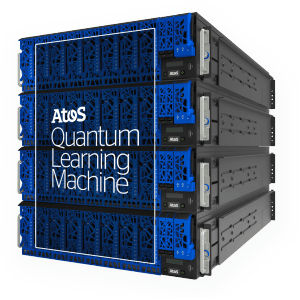Jul 5 2017
Atos, an international leader in digital transformation, recently launched the world's first commercially available machine-system that is designed to simulate up to 40 quantum bits (Qubits). The simulator, christened ‘Atos Quantum Learning Machine’ (Atos QLM), is powered by an ultra-compact supercomputer and a universal programming language.
 Credit: Atos
Credit: Atos
Available in five power configurations (30 to 40 Qubits) to handle the requirements of various organizations, Atos QLM enables Scientists, Engineers and Students to develop and test present-day quantum applications as well as algorithms of tomorrow. The machine, engineered by the ‘Atos Quantum’ laboratory - the first big quantum industry program in Europe, introduced in November 2016 – has created a number of top-class innovations which have paved the way for multiple patent applications.
Today, by unveiling the highest-performing commercial quantum simulator in the world, Atos reaffirms both its ambition to be the industry leader in Europe and its role to accompany its clients from the outset in what is likely to be the next major technological evolution. Quantum physics will lead to profound changes notably in cybersecurity, one of the key strategic priorities of businesses. We must be planning for the impact of these today. The teams at our Atos Quantum laboratory have made remarkable progress, recognized and supported by an internationally renowned Scientific Council, to provide, today, scientists and engineers from around the world with a simulation environment which enables them to develop quantum algorithms to prepare for the major accelerations to come.
Thierry Breton, Chairman and CEO of Atos
Overcoming the physical boundaries of current computing...
Whereas Moore's Law[1], which rules the microprocessor sector and has structured computing for more than 50 years, will soon become outdated. The quantum computer - based on the doctrine of quantum mechanics - is projected to overcome the physical boundaries of today’s computing, thereby paving the way for new opportunities, especially in intensive computing.
...and anticipating the next major disruptions in cyber security
Amongst the calculating capabilities offered by quantum computing is quasi-instantaneous factorization in prime numbers (Shor’s algorithm) which would make the most of the present asymmetric encryption algorithms, such as RSA - the foundation of all existing internet security and banking systems - vulnerable.
Therefore, Atos is already aiming to implement ‘quantum safe’ security algorithms, the level of complexity of which would facilitate data to be protected from any illegal decryption, including by a quantum computer.
Atos Quantum Learning Machine: an easily installable turnkey solution for researchers and developers
This is why Atos has built the Atos Quantum Learning Machine (Atos QLM), the first commercial quantum simulator, powered by a new ultra-compact supercomputer and a common programming language. Atos QLM will also be used to work towards new quantum algorithms, and will be available for the entire developer and scientific communities.
- A universal programming language: aQasm (Atos Quantum Assembly Language)
The teams working in the Atos Quantum laboratory have formulated a common language:
- 100% quantum: aQasm can be carried out as of today on a quantum simulator but also on physical quantum computers or quantum accelerators as soon as they are developed;
- Configurable: aQasm provides the ability to program quantum gates (by analogy to the Boolean gates of classical computing) and to mix them with other existing quantum gates so as to deliver more complete extensions;
- Standardized: aQasm is the universal language of all future developments from the Atos Group on quantum, guaranteeing interoperability over time and an easy transition to quantum.
Owing to this universal configuration, aQasm enables connectors, which convey programs from other quantum simulators, to be created.
- A new ultra-compact supercomputer, the same size as an enterprise server
Atos Quantum teams have engineered a new ultra-compact supercomputer to operate this common quantum language, which offers:
- The capability to process Qubits in memory and thus accelerate processing;
- A unique firmware (micro-software incorporated in the hardware) enhancing the data exchanges as described in the quantum model developed in aQasm;
- Specific hardware components to speed-up specific quantum calculations and which can ultimately be substituted by quantum accelerators.
The fact that this machine is the same size as a regular business server means it can easily be set-up on-site at all types of clients.
Outstanding results praised by a world-class Scientific Council
As work advances, Atos Quantum will carry on working with a world-famous Scientific Council, the last meeting of which was on 31st May, and which accepted the scientific value of Atos’ work.
There is real excitement about new technologies like Quantum Computing, however many things are needed to help users learn how to program and use Quantum computers. By providing universities, research institutes and both large and small businesses across the world access to its QLM, Atos is enabling organizations to experiment with Quantum computing and prepare for this potential revolution in computing. With this announcement Atos is providing a market accelerator for learning how to do Quantum computing.
Earl Joseph, CEO at Hyperion Research – formerly IDC Research
Going forward, quantum computing should be able to handle the sudden increase of data brought about by the Internet of Things and Big Data. On account of its innovative targeted computing acceleration capabilities based specifically on the exascale class supercomputer Bull Sequana[2], quantum computing should also promote developments in algorithms, deep learning and artificial intelligence for domains as diverse as new materials or pharmaceutical. To progress on these issues, Atos aims to link up with Research Centers and Universities worldwide.
References:
[1] In 1965, the Co-Founder of Intel, Gordon Moore, observed that the number of transistors per microprocessor doubled every 12 months (then every 24 months from 1975), which gave birth to ‘Moore’s Law’, taken on by the processor industry as a target to follow.
[2] Launched in April 2016, the Bull Sequana is the most powerful supercomputer in Europe, capable in the coming years of processing a billion billions operations per second.